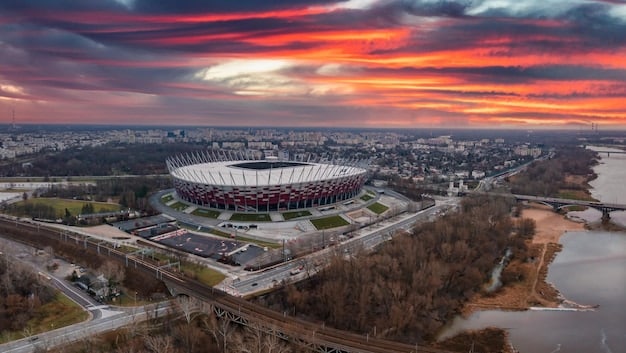World Cup 2026: USA’s Hosting History & Future Impact

The World Cup 2026: The History of the World Cup in the United States marks a significant milestone, building on a legacy that began with the groundbreaking 1994 tournament, showcasing the nation’s evolving role and growing passion for football on the global stage, solidifying its place in FIFA history.
As the countdown to 2026 begins, the anticipation grows for one of the most monumental events in sports history: the FIFA World Cup returning to North America, prominently featuring the United States as a host nation. This isn’t the first time the U.S. has welcomed the world’s most popular sport to its shores. The journey of the World Cup 2026: The History of the World Cup in the United States is a fascinating narrative of growth, challenges, and a burgeoning love affair with “the beautiful game,” fundamentally altering perception and participation in the sport.
The Groundbreaking 1994 FIFA World Cup in the USA
The 1994 FIFA World Cup was a pivotal moment not just for football in the United States, but for the sport globally. It defied skeptics who doubted the U.S. could host such a massive event successfully, particularly given the relative infancy of professional soccer in the country at the time. This tournament left an indelible mark, proving that the American market had an immense appetite for the sport, far exceeding initial expectations.
The decision to award the World Cup to the United States was bold, aimed at expanding football’s reach into new territories. Critics pointed to the lack of a strong professional league and a general unfamiliarity with soccer among the mainstream American public. However, FIFA’s vision was long-term, sensing the potential for growth. The tournament’s astonishing success proved them right.
Record-Breaking Attendance and Beyond
One of the most immediate and impactful legacies of USA ’94 was its unprecedented attendance figures. The tournament saw an average attendance of nearly 69,000 spectators per match, a record that stands to this day, surpassed by no other World Cup. This massive turnout underscored the latent interest in soccer across the nation.
- 🏟️ **Highest Total Attendance:** Over 3.5 million spectators across 52 matches.
- 📈 **Unmatched Average Attendance:** Far exceeded previous World Cups, proving American enthusiasm.
- 💥 **Economic Impact:** Generated significant revenue, showcasing the commercial viability of soccer in the U.S.
Beyond the raw numbers, the tournament fostered a cultural shift. Americans, traditionally drawn to baseball, basketball, and American football, were captivated by the global spectacle. Iconic moments, such as Roberto Baggio’s missed penalty in the final, are etched in the memories of a generation. The success of 1994 directly led to the formation of Major League Soccer (MLS) in 1996, fulfilling a key condition set by FIFA for hosting the tournament. This paved the way for professional club soccer to finally establish a sustainable presence in the U.S. sports landscape. The tournament also showcased the U.S.’s capability in terms of infrastructure and logistics, utilizing state-of-the-art stadiums and efficient transportation networks, setting a benchmark for future host nations.
Evolution of Soccer in the US Post-1994
The period following the 1994 World Cup was one of crucial development for soccer in the United States. The establishment of Major League Soccer (MLS) was the most significant immediate outcome, providing a domestic professional league that had been sorely missing. This new league faced initial challenges but steadily grew, adapting to the unique American sports market. From humble beginnings with 10 teams, the MLS has expanded significantly, now boasting over two dozen clubs, each with dedicated fan bases and modern stadiums.
Early MLS teams focused on attracting international stars nearing the end of their careers, such as Pelé in the NASL era, but also aimed to develop homegrown talent. The league experimented with rules, like the shootout to decide tied matches, to appeal to American audiences, though most of these unique rules were eventually abandoned in favor of FIFA’s international standards. The growth of MLS was instrumental in nurturing a domestic soccer culture.
The Rise of Youth Soccer and Grassroots Development
The impact of the 1994 World Cup extended far beyond professional leagues to the grassroots level. Youth soccer participation exploded across the country. Millions of American children, inspired by the global event, joined local leagues and clubs. This surge in youth participation created a deeper talent pool and a broader understanding of the game.
- ⚽ **Increased Youth Participation:** Dramatic rise in youth soccer programs and leagues nationwide.
- 🏫 **Collegiate Soccer Growth:** Stronger pathways for athletes through college-level programs.
- 👩👩👧👦 **Fan Base Expansion:** A new generation of fans grew up with soccer as a legitimate sport.
Simultaneously, the U.S. national team saw a significant improvement in its performance on the international stage. The U.S. Men’s National Team (USMNT) consistently qualified for the World Cup in the decades following 1994, reaching the quarterfinals in 2002, their best performance in the modern era. The U.S. Women’s National Team (USWNT), already a powerhouse, further cemented its dominance, winning multiple World Cups and Olympic gold medals, significantly contributing to the sport’s popularity and inspiring millions. The expansion of professional academies, better coaching education, and increased media coverage have also played vital roles in integrating soccer into the mainstream American sports consciousness. This evolution set the foundation for the U.S. to once again bid for, and ultimately win, the rights to co-host the World Cup.

The Joint Bid for World Cup 2026: USA, Canada, and Mexico
The decision to host the 2026 FIFA World Cup marked a new era in the tournament’s history with the first-ever three-nation joint bid. The United Bid, comprising the United States, Canada, and Mexico, successfully outmaneuvered Morocco to secure the hosting rights. This unique partnership was a strategic move, leveraging the combined strengths and infrastructure of three distinct North American footballing nations. For the U.S., it represented a homecoming, an opportunity to showcase the rapid development of soccer since 1994.
The bidding process was rigorous, with both contenders presenting compelling cases. The United Bid emphasized the robust infrastructure already in place, including numerous world-class stadiums, extensive transportation networks, and a proven track record of hosting large-scale international events. The collaborative nature of the bid was also a key factor, highlighting regional unity and a shared passion for the sport across diverse football cultures.
Advantages of the North American United Bid
The United Bid presented several undeniable advantages that ultimately swayed FIFA’s decision. The sheer scale and existing facilities were paramount. Unlike many previous World Cups, there was no need for extensive new stadium construction, significantly reducing costs and environmental impact.
- 🏟️ **Existing Infrastructure:** Abundance of modern, large-capacity stadiums ready for use.
- ✈️ **Logistical Expertise:** Proven capacity to manage large international events and diverse fan bases.
- 💰 **Economic Strength:** Strong economies capable of supporting massive commercial opportunities.
Furthermore, the significant growth of soccer’s popularity across all three nations since 1994 provided a compelling narrative. Each country brings its unique footballing history and cultural flavor to the tournament. Mexico, a two-time World Cup host (1970 and 1986), adds historical prestige. Canada, having successfully hosted the Women’s World Cup in 2015, demonstrates its readiness. The U.S., with its vast market and renewed soccer fervor, serves as the dominant partner. This joint venture is set to be the largest World Cup to date, featuring 48 teams for the first time, necessitating a geographically diverse and expansive hosting solution that only a united bid could truly provide. The combined effort aims to deliver an unforgettable global festival of football.
Economic and Cultural Impact of World Cup 2026 on the US
The World Cup 2026 is poised to deliver an unprecedented economic and cultural boon to the United States. With the expanded format featuring 48 teams and a record number of matches, the scale of financial activity will be immense. Host cities across the U.S. are anticipating a surge in tourism, hospitality, and related industries. The direct economic benefits will stem from visitor spending on accommodation, dining, transportation, and local attractions, as well as significant investments in infrastructure upgrades and service provision.
Beyond the immediate financial gains, the tournament will generate substantial indirect economic effects. Job creation in various sectors, from event management and security to retail and media production, will be a significant positive outcome. Local businesses, large and small, will experience increased demand. The exposure gained by host cities and the U.S. as a whole on the global stage will also translate into long-term tourism interest and potential foreign investment. The tournament is effectively a massive marketing campaign for the host nation.
Cultural Transformation and Legacy
Culturally, the World Cup 2026 is set to accelerate the integration of soccer into the fabric of American society. While 1994 laid the groundwork, 2026 will solidify soccer’s status as a major sport alongside the established “big four.” The sheer volume of international fans and media converging on U.S. soil will create an immersive global experience, exposing more Americans to the vibrant, diverse cultures that football brings.
- 🚀 **Accelerated Soccer Growth:** Further mainstream adoption of soccer in American sports.
- 🌐 **Global Cultural Exchange:** Increased interaction and understanding between diverse communities.
- legacy: long-term economic benefits and enhanced global perception.
The legacy of World Cup 2026 will extend beyond the final whistle. It is expected to further boost youth participation, inspire future generations of players, and strengthen the fan base for MLS and international soccer. The tournament will also foster a deeper appreciation for the sport’s global appeal and its capacity to unite people from different backgrounds. Infrastructure improvements, particularly in public transport and venue connectivity, will leave a lasting positive impact on host cities. The cumulative effect will be a more deeply entrenched football culture and a reinforced image of the U.S. as a capable and enthusiastic host for major international events.
Infrastructure Ready for a Global Spectacle
The United States, as a co-host of the 2026 FIFA World Cup, is uniquely positioned regarding infrastructure readiness. Unlike many previous host nations that initiated massive construction projects, the U.S. already possesses a wealth of modern, state-of-the-art stadiums originally built for American football, baseball, or multi-purpose use. These venues boast capacities far exceeding FIFA’s requirements, ensuring millions of fans can experience the matches live. This existing infrastructure significantly reduces the financial burden and environmental impact typically associated with hosting an event of this magnitude.
The selection of host cities across the U.S. was carefully considered, balancing geographical spread with logistical capabilities. Each chosen city offers not only immense stadium capacity but also robust transportation networks, including major international airports, extensive road systems, and in many cases, efficient public transit. This ensures smooth movement for teams, officials, and millions of visiting fans. Beyond the stadiums, the U.S. features a highly developed hospitality sector, with ample accommodation options ranging from luxury hotels to budget-friendly lodgings, prepared to host the influx of visitors.
Technological Integration and Fan Experience
Beyond physical structures, the U.S. has a strong reputation for technological innovation, which will be leveraged to enhance the fan experience for World Cup 2026. The selected stadiums are equipped with advanced connectivity, large display screens, and modern amenities. This technological prowess will facilitate everything from digital ticketing and contactless payments to immersive fan zones and real-time information dissemination.
- 📱 **Cutting-Edge Technology:** Advanced connectivity and digital solutions for fan engagement.
- 🚌 **Efficient Transportation:** Comprehensive networks to manage large crowds effortlessly.
- 🏨 **Extensive Hospitality:** Ample and diverse accommodation options for global visitors.
Furthermore, the security and emergency services infrastructure in the U.S. is highly sophisticated, essential for managing such a large-scale event safely. Experience from hosting numerous Super Bowls, Olympic Games, and other major international competitions provides a well-tested framework for crowd control, crisis management, and public safety. The existing training facilities, hotels, and logistics hubs also minimize the need for new development. This collective readiness underscores the U.S.’s capability to deliver a seamless and memorable World Cup experience, focusing resources on refining operations rather than fundamental construction. The robust foundation ensures the tournament can focus on the football spectacle and the cultural celebration it represents.

Beyond 2026: The Future of Soccer in the United States
The 2026 FIFA World Cup is not merely an event; it’s a catalyst for the next phase of soccer’s evolution in the United States. Its scale, media exposure, and direct engagement with millions of Americans are set to solidify the sport’s position as a permanent fixture in the national consciousness. The momentum generated by hosting such a prestigious tournament will undoubtedly accelerate growth in several key areas, ranging from youth development to professional league expansion.
The legacy of 2026 will extend well into the future, creating a lasting impact on how soccer is perceived and consumed in the U.S. There’s a strong expectation that the league will expand further, potentially adding more teams and attracting a higher caliber of international talent. The increased exposure will lead to more substantial investment in club infrastructure, youth academies, and coaching development, ensuring a continuous pipeline of homegrown players capable of competing on the world stage.
MLS Expansion and Long-Term Fan Engagement
The trajectory of Major League Soccer (MLS) is particularly poised for significant advancement post-2026. The tournament will serve as a massive showcase for the league’s growth, drawing in new fans and potentially inspiring more cities to pursue MLS franchises. This expansion will bring the professional game closer to more communities, fostering local rivalries and strengthening regional soccer identities.
- 📈 **Continuous MLS Growth:** Further expansion of teams and fan bases across the country.
- ⭐ **Enhanced Player Development:** Increased investment in academies and youth pathways.
- 📺 **Broader Media Coverage:** More extensive broadcasting deals and mainstream sports visibility.
Furthermore, the 2026 World Cup will inevitably reshape media consumption habits. Mainstream sports media outlets will likely dedicate more coverage to both domestic and international soccer, reflecting its undeniable popularity. This increased visibility will attract larger sponsorship deals and advertising revenue, further fueling the sport’s development at all levels. The long-term vision is for the U.S. to not only be a consistent World Cup contender but also a global leader in soccer innovation, coaching, and fan engagement. The tournament often leaves behind a strengthened collective memory and an enduring legacy of passion for the beautiful game, and 2026 is expected to be no exception for the United States. It’s truly about cultivating a lasting relationship between a nation and the world’s most beloved sport, ensuring that soccer’s future in America is brighter than ever.
| Key Point | Brief Description |
|---|---|
| 🌍 USA ’94 Legacy | Set attendance records, leading to MLS formation and significant soccer growth. |
| 🤝 United Bid 2026 | USA, Canada, and Mexico’s joint effort secured the largest World Cup in history. |
| 💲 Economic Impact | Expected to generate massive tourism revenue and job creation for host cities. |
| 🏗️ Infrastructure Readiness | Existing stadiums and transport networks ensure efficient, world-class hosting. |
Frequently Asked Questions About the History of the World Cup in the US
▼
The United States first hosted the FIFA World Cup in 1994. This marked a significant moment for the sport in North America, as it was the first time the tournament was held in a country where soccer was not traditionally the dominant sport. Despite initial skepticism, USA ’94 proved to be a resounding success, breaking attendance records.
▼
The 1994 World Cup had a transformative impact on soccer in the U.S. Its success led directly to the establishment of Major League Soccer (MLS) in 1996, providing a much-needed professional domestic league. It also sparked a massive increase in youth soccer participation and significantly raised the sport’s profile and popularity across the nation, paving the way for future growth.
▼
Including the upcoming 2026 tournament, the United States will have hosted the FIFA World Cup twice. The first instance was in 1994. For 2026, the U.S. is the primary co-host of a joint bid with Canada and Mexico, marking an unprecedented three-nation World Cup, showcasing a broader regional collaboration for the global event.
▼
The 1994 World Cup in the U.S. remains unique for its extraordinary attendance figures. It holds the record for the highest total attendance in World Cup history, with over 3.5 million spectators, and the highest average attendance per match, close to 69,000. These numbers underscored a significant and previously underestimated interest in soccer among the American populace.
▼
For World Cup 2026, the U.S. is expected to deliver a massive and technologically advanced tournament. With its extensive existing infrastructure, including numerous world-class stadiums and transportation networks, the focus will be on leveraging these assets for an unparalleled fan experience. The tournament is anticipated to further cement soccer’s place as a major sport in the U.S. and yield significant economic benefits.
Conclusion
The journey of the FIFA World Cup in the United States, from the groundbreaking 1994 tournament to the expansive co-hosting of 2026, is a testament to the nation’s evolving relationship with soccer. What began as a bold move to introduce the sport to a new market has blossomed into a formidable presence on the global footballing stage. The upcoming World Cup, with its expanded format and joint hosting across North America, symbolizes not just growth in scale, but also a deeper cultural integration of “the beautiful game” within American society. The legacy of 1994 paved the way for professional leagues and grassroots development, setting the stage for 2026 to elevate the sport to unprecedented heights. Beyond the economic impact and logistical triumphs, 2026 is set to further ignite passion, inspire future generations, and solidify the United States’ reputation as a passionate and capable hub for world-class soccer.





